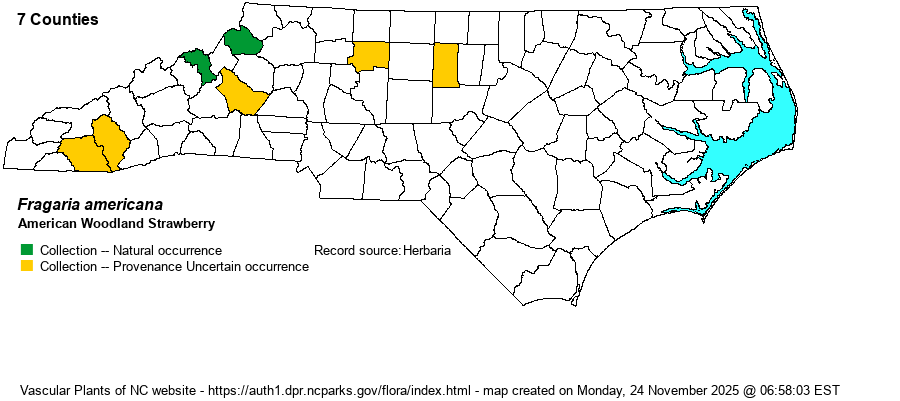| Author | (Porter) Britton | |
| Distribution | Believed to be native only to Watauga County, and perhaps at Roan Mountain (Mitchell County), though there are collection records for several other counties in the Piedmont and the southern Mountains (mostly from obviously non-natural habitats). A few more collections from the southern Piedmont and the Coastal Plain are excluded from the map as being well out of the expected range.
This is a very widespread species across Canada and the Northern states; ranging south to eastern VA, northwestern NC, and MO. | |
| Abundance | Extremely rare, and collected only a few times from Watauga County and once from Mitchell County, the only counties the website editors feel lie within the natural range. The NCNHP treats the species as Significantly Rare; it gives its State Rank as SH (Historical), though the editors feel that S1 is more realistic, assuming there are recent records. | |
| Habitat | This species grows in rich forests, generally where rocky. It can grow in disturbed areas and edges, but there it might be considered of uncertain provenance, at least in NC. | |
| Phenology | Blooms from May to July, and fruits shortly after flowering. | |
| Identification | The two species of "wild strawberries" are quite similar, and caution is needed before identifying this rare one in the state. Each is a short plant, growing barely 6 inches tall, with scattered basal leaves and a flowering stem from this base. Each has leaves as three distinct leaflets, rounded in shape, about 1-1.5 inches long and slightly less wide, with toothed margins. In this species, the principal lateral veins diverge from the midrib at roughly an angle of 45 degrees, whereas in the common F. virginiana the lateral veins diverge from the axil at a shallower angle, around 30 degrees. The inflorescences are different; this species has flowers in a raceme or panicle, and thus longer than wide, whereas in the other the flowers have very similar pedicel lengths and the cluster is rounded or broad (in a corymb). Also, the flowers of this rare species are small, the 5 rounded, white to creamy-white petals have a spread of barely 1/2-inch at most, whereas flowers of F. virginiana are larger, about 2/3-inch across. Each species has a small strawberry fruit, but this species has the sepal lobes spreading away from the developing fruit, whereas in the other the calyx lobes are appressed to the developing fruit. The most obvious character to look for in this species is the flower cluster that is longer than wide, extending well beyond the leaves.
| |
| Taxonomic Comments | Most older references, and many current ones, treat this as a species within the circumboreal F. vesca -- as F. vesca var. americana. Weakley (2018) treats these two taxa as separate species, with F. vesca being a European taxon.
| |
| Other Common Name(s) | Woodland Strawberry; however, this is the most often used common name for the larger species complex of F. vesca. | |
| State Rank | SH [S1] | |
| Global Rank | G5T5 [G5] | |
| State Status | SR-P | |
| US Status | | |
| USACE-agcp | | |
| USACE-emp | | |

